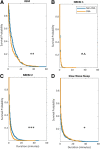Effects of obstructive sleep apnea on human spatial navigational memory processing in cognitively normal older individuals
- PMID: 33399067
- PMCID: PMC8320476
- DOI: 10.5664/jcsm.9080
Effects of obstructive sleep apnea on human spatial navigational memory processing in cognitively normal older individuals
Abstract
Study objectives: Obstructive sleep apnea (OSA) prevalence increases with age, but whether OSA-related sleep disruption could interrupt the processing of previously encoded wake information thought to normally occur during sleep in cognitively normal older adults remains unknown.
Methods: Fifty-two older (age = 66.9 ± 7.7 years, 56% female), community-dwelling, cognitively normal adults explored a 3-D maze environment and then performed 3 timed trials before (evening) and after (morning) sleep recorded with polysomnography with a 20-minute morning psychomotor vigilance test.
Results: Twenty-two (22) participants had untreated OSA [apnea-hypopnea index (AHI4%) ≥ 5 events/h] where severity was mild on average [median (interquartile range); AHI4% = 11.0 (20.7) events/h] and 30 participants had an AHI4% < 5 events/h. No significant differences were observed in overnight percent change in completion time or in the pattern of evening presleep maze performance. However, during the morning postsleep trials, there was a significant interaction between OSA group and morning trial number such that participants with OSA performed worse on average with each subsequent morning trial, whereas those without OSA showed improvements. There were no significant differences in morning psychomotor vigilance test performance, suggesting that vigilance is unlikely to account for this difference in morning maze performance. Increasing relative frontal slow wave activity was associated with better overnight maze performance improvement in participants with OSA (r = .51, P = .02) but not in those without OSA, and no differences in slow wave activity were observed between groups.
Conclusions: OSA alters morning performance in spatial navigation independent of a deleterious effect on morning vigilance or evening navigation performance. Relative frontal slow wave activity is associated with overnight performance change in older participants with OSA, but not those without.
Keywords: Alzheimer disease; EEG; SWA; elderly; learning.
© 2021 American Academy of Sleep Medicine.
Conflict of interest statement
All authors have read and approved the final manuscript. Work for this study was performed at the authors’ respective institutions. This work was supported by grants from NIH/NIA/NHLBI R01AG056682, R21AG059179, R21AG055002, R01HL118624, R01AG022374, R01AG056531, R01AG056031, K24 HL109156, and P30AG008051; Alzheimer’s Association grant 2018-AARG-589632; Merck Investigator Studies Program; the American Sleep Medicine Foundation Junior Faculty Award 152-JF-16; the American Thoracic Society Foundation; and the Friedman Brain Institute. The authors report no conflicts of interest.
Figures






References
Publication types
MeSH terms
Grants and funding
LinkOut - more resources
Full Text Sources
Other Literature Sources

